UNO. DUE. TRE STRIKES you’re out — way out — in baseball in Italy

BOLOGNA, Italy — “FUORI CAMPO!” yelled the tall, curvy blonde with the microphone. “QUATTRO OUTS! DUE FUORI CAMPO!” (FOUR OUTS! TWO HOME RUNS!) A baseball player the size of your average second baseman digs back in and tries cranking another one over the 101-meter (333-foot) left-field fence. Instead, he dribbles one to the left side of the infield.
It’s home run derby Italian style. It’s where the players aren’t very big and neither are the crowds. But it’s where the best in a country that has had baseball since World War II have gathered to show why Italy is one of the up and coming baseball nations in the world.

I’m attending the Italian Baseball League All-Star Game and if this event escaped you last weekend, don’t kick yourself. On Italy’s sports radar, baseball hovers somewhere off the dark side of Neptune. My best friend, Alessandro Castellani, is an esteemed sportswriter for ANSA, Italy’s national wire service. Raised in Rome, he regularly covers soccer and rugby. He’s covered numerous Olympic Games. Yet he unabashedly says of baseball, “I don’t even know the rules.”
Marco Landi is the marketing director for FIBS, Italy’s baseball federation. I had lunch with him in Rome before last weekend’s All-Star Game and asked him about Italians’ reaction to baseball.
“They say, ‘Too many rules. I don’t understand. I saw the movie with Robert Redford,’” he tells me.
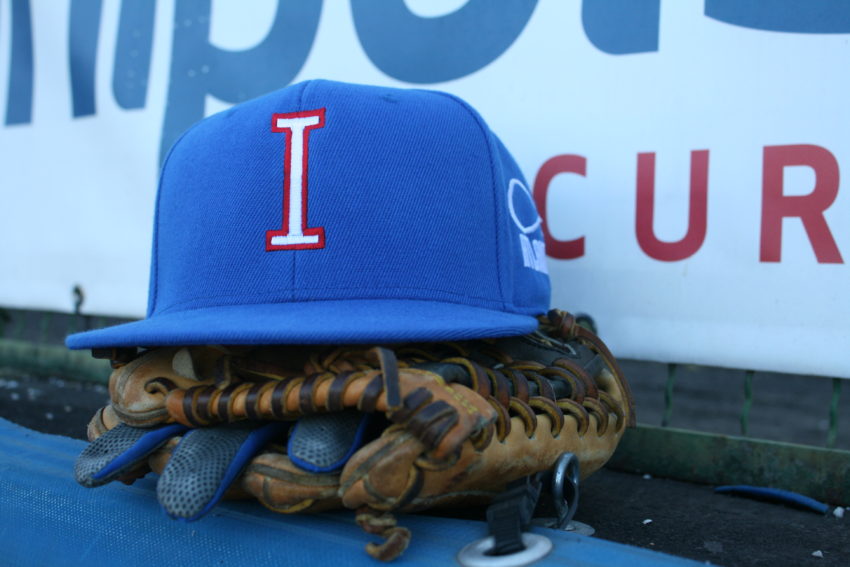
I had not seen a baseball game since the 2013 World Series. I’d gone nearly two years without even a popup. For a guy who played the game for 10 years and covered the major leagues as a journalist for seven, I felt in need of a baseball fix. I wanted to smell popcorn in the concession stands, pine tar around the batting cage. Baseball has smells no other sport has. Unlike most sports, these smells are pleasant.
So I go to the Italian Baseball League’s All-Star Game in Bologna. This city smack dab in the middle of Italy is the capital of Emilia-Romagna, the region best known for the greatest cuisine in Italy. It is known for culatello ham cured for 36 months and Parmigiano cheese the locals eat like giant gum drops. It is not known for hulking first basemen or 95 mph fastballs. But Italy does have its pockets of interest. Bologna is one of them. I learn fast after my train from the city center drops me off in the southwest part of town. I was three kilometers from Stadio Gianni Falchi. I wonder if anyone knows what the hell Falchi is, let alone where it is. I walk into a Tabacchi shop and ask to call a taxi. The man behind the counter not only knows where the stadium is, he knows the all-star game is in town.
“I love baseball,” says Claudio, standing a husky 6-foot-1. “I played from 6 to 16 years old.”
Eschewing a taxi, Claudio gives me a ride to the stadium and tells me he was a first baseman-pitcher for club teams growing up. However, like a lot of Italian youth who love the game, he never developed enough to get past the recreational level. The players I’m about to watch, made it, relatively speaking.

Franchi is a small, concrete, pillbox of a stadium in a wooded area that also envelops a couple of small diamonds. A youth game with boys and girls on the same team is playing on one of them. Franchi has big beams holding up a tiny roof that covers a grandstand holding 2,500 people. Built in 1969, it looks like a Class A stadium in a small Deep South or Iron Belt town that has fallen on hard times. It has the usual trappings of U.S. stadiums. It has a souvenir truck selling blue Italian national team caps and jerseys with “ITALIA” written in script across the front. One truck sells nothing but baseball equipment. Come to think of it, it’s the first baseball equipment I’ve ever seen sold in Italy.

However, I knew I wasn’t in the U.S. when I passed the concession stands. Here they sell porchetta, the sizzling, suckling pork chunks, served in homemade buns, that tastes as good as it sounds. Also, another stand sells Nutella waffles. Nutella is the Italian chocolate spread institution every Italian from Sicily to the Dolomites grew up on and takes a hidden addiction into old age. Picture rich, deep chocolate you spread like peanut butter between two crisp waffles and you have a snack that could wipe out Dodger Dogs from Dodger Stadium.
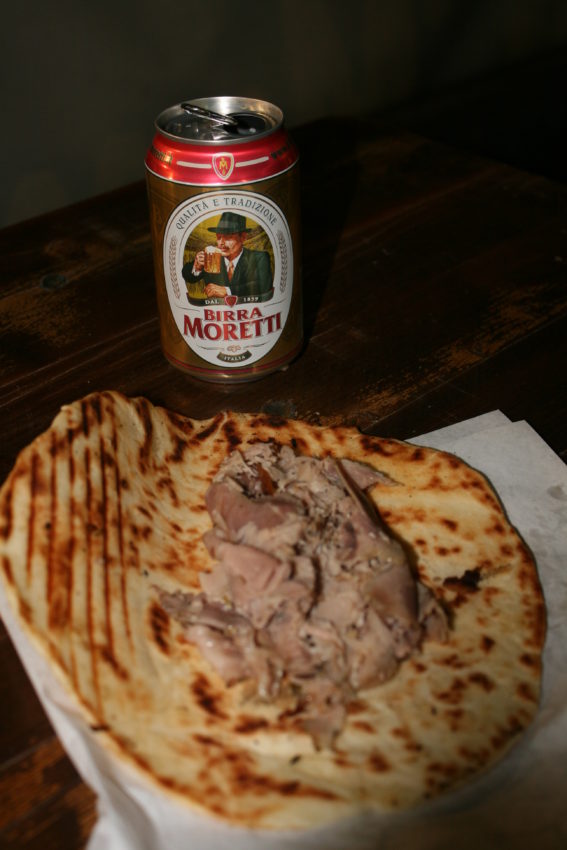

Behind the stands I meet Landi who shepherds me onto the field where the players are taking batting practice. This game pits the Italian national team against the Italian Baseball League All-Star team. Since nearly the entire national team is made up of IBL players, half the IBL all-star roster is Latin Americans, among the four foreign-born players each Italian team is allowed. The Italian players look like any other group of baseball players you’d see in the U.S. Nearly all wear their pant cuffs down by their ankles. Their shades rest atop their cap bills. Lumps of tobacco can be seen protruding from some of their lower lips. They scratch a lot. Yes, they are baseball players, all right. (True confession: The one thing I miss most about playing baseball, besides the camaraderie and the smell of the grass on a warm Saturday afternoon, was the freedom — and expectation per baseball’s social mores — to scratch my dick in public.)
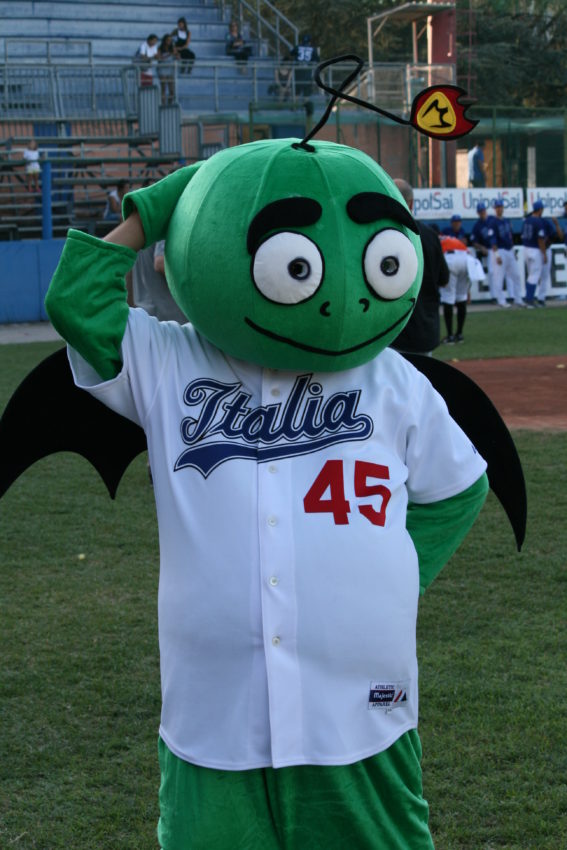
Baseball is not a novelty in Italy. An esteemed Major League Baseball writer and obvious zenophobe who loathes soccer said the only reason Italians love soccer is because they don’t have a choice.
WRONG! An American all-star team put together by Chicago White Stockings owner Albert Spalding came through Italy in 1889. The terrific book on Italian baseball history, “Azzurri on the Diamond,” even has a picture of American players in full 19th century uniforms inside the Roman Colosseum. U.S. troops brought baseball to Italy in World War II and the Italian Baseball League began in 1948. Italy played its first national game in 1952 in Rome against Spain. There’s even a picture of Gregory Peck, in Rome to film “Vacanze Romane,” throwing out the first pitch in coat and tie.
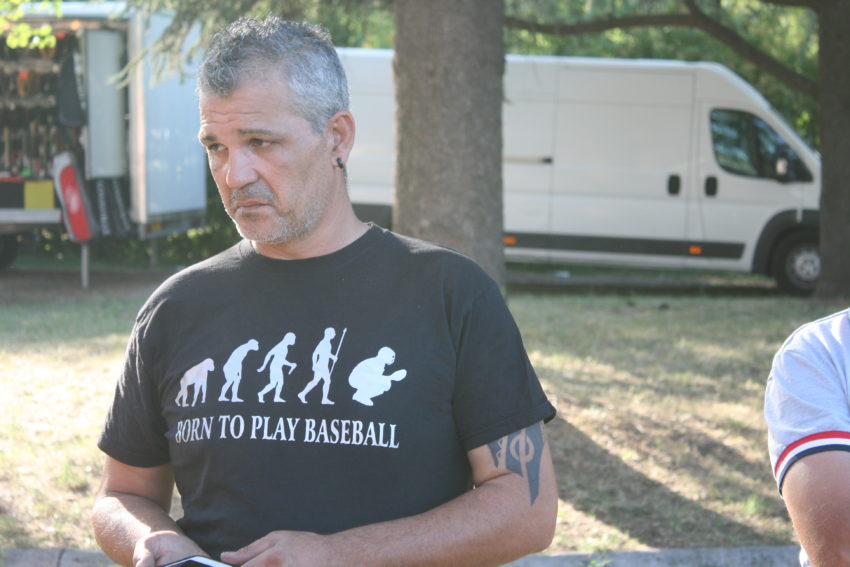


So baseball has been played in Italy for about 70 years yet its impact on the national level doesn’t go much beyond the names of DiMaggio, Berra, Rizzuto, Torre and Piazza, Major League Baseball Hall of Famers who could barely pronounce “gelato.” Only seven Italian-born players have made the major leagues. Only one has made it after growing up playing in Italy: San Remo’s Alex Liddi who played with the Seattle Mariners in 2011 and is now with the Northwest Arkansas Naturals, Kansas City’s Double-A team. Six play in the minor leagues today.
There are sound cultural reasons. Italian boys only play about two games a week. Their summer season ends at the end of June. It has nothing to do with weather. Have you ever been to Italy in summer?
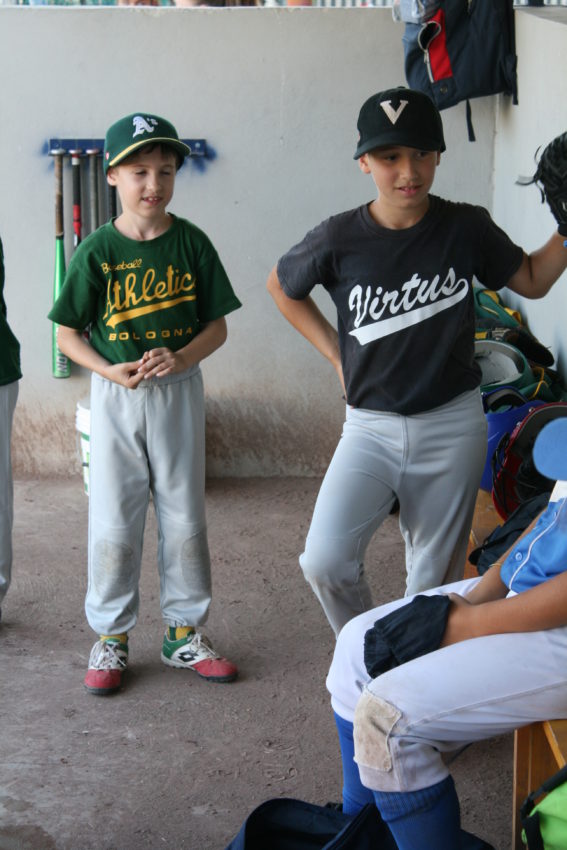
“Italians don’t want anything that binds you to a schedule,” said Landi, a Bologna native who played as a youth. “Families don’t want anything to affect their weekends. The majority of kids get kidnapped by grandma and taken to the seaside.”
I chat with All-Star outfielder Claudio Liverziani, one of the patron saints of the Italian Baseball League. His dark, swarthy looks belie his 40 years, half of which have been played in the IBL. Today he’s a married father. He said his parents dragged him to the sea every summer.
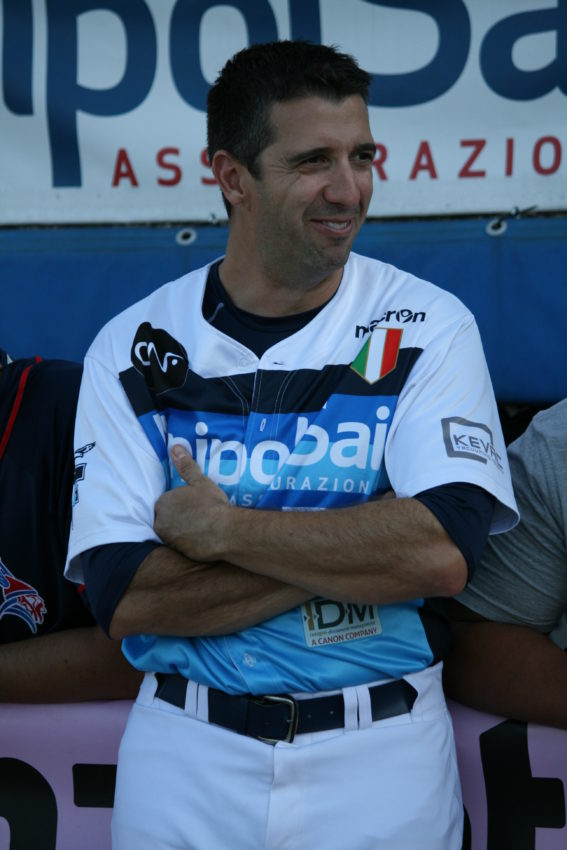
“I’m going to do the same,” he says. “I have no choice. Otherwise, I’d have to hire a babysitter for two months.”
Also, drive around Italy anywhere — cities, countryside, seaside resorts — none of the schools have sports facilities. School sports are more of an American institution but in Italy, sports in schools were discouraged and sports facilities were never even considered. It was a post-Mussolini reaction to fascism. While he was still hanging by his toes in Milan, war-weary Italians felt sports were too much of a priority under fascism — along with, of course, oppression, racism and murder.
“Yet when kids get introduced to baseball,” Landi says, “they say, ‘Give me a ball and bat! Let’s hit!’”
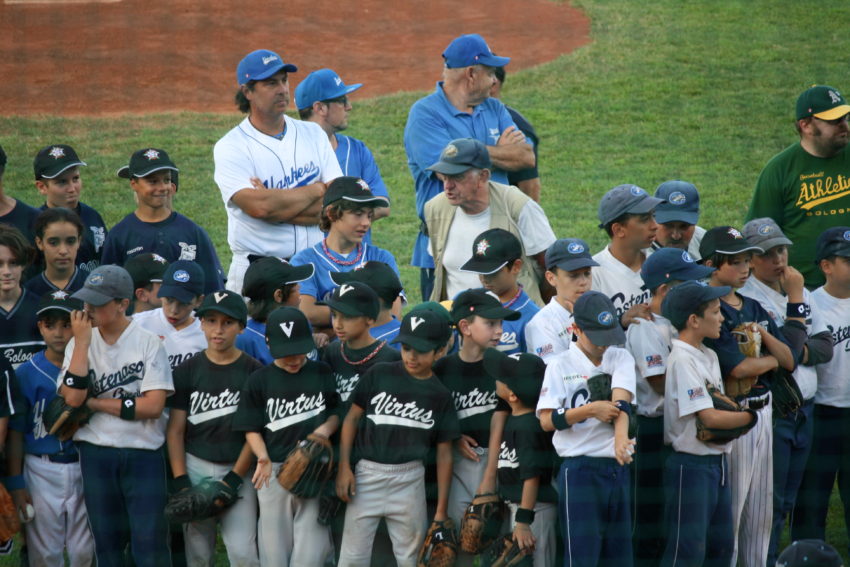
The numbers are surprisingly high. Italy has 18,000 registered youth and senior players playing on 800 teams in 300 clubs. There are 200 fields, 16 at the international level. Not that kids know any real players. They don’t see baseball on TV and they don’t see it in the newspapers. Baseball in Italy today gets about as much press coverage as bridge. My Corriere dello Sport, one of Italy’s three national sports dailies, will run scores and standings on the last of its 28 or 32 pages. That’s it. In a year and a half of reading sports pages in Rome, I have never read a baseball feature. Nothing would shed light on a sport that nevertheless is gaining street cred at the international level.
Landi remembers regular coverage of the league until 1982. That’s when Italy won soccer’s World Cup in Spain and soccer knocked everything else off the sports radar. It’s currently soccer’s off season yet 18 of the 40 pages in Saturday’s La Gazzetta dello Sport are devoted to soccer and its free-agent market. Another six are full-page ads. The IBL has begun its playoffs and La Gazzetta ran two paragraphs.
Yet baseball thrives in some Italian towns. Alessandro Grimaldo, a graduate of Italy’s esteemed baseball academy in the Tuscan town of Tirrenia, grew up in Nettuno. A beach town about 40 miles south of Rome, Nettuno has one of the world’s biggest American war cemeteries, holding the graves of 7,861 soldiers who died defending Italy in World War II. Nettuno’s baseball museum today shows GIs wielding bats in the streets near the sea, the same streets where kids like Grimaldo played. It’s Italy’s version of stickball in Brooklyn. Nettuno even has two IBL teams.
Baseball is big in the Adriatic Coast city of Rimini and in Padua, just west of Venice. Even San Marino, the world’s oldest continuously independent republic, has a long-standing tradition. But there’s a problem in player development.
“We don’t play enough,” Liverziani says. “We don’t have the confidence with the ball like an American kid who plays right out of kindergarten and plays almost every day. Here you play 20 games a year.”
Still, Italy is rising internationally. It reached the second round of the last World Baseball Classic in 2013 before losing to Dominican Republic, 5-4, and Puerto Rico, 4-3, both after leading in the eighth inning. They split two games with a Japanese all-star team that played a Major League all-star team. They’ve won 10 European Championships. Mike Piazza is their batting coach.
Marco Mazzieri, the national team coach, was introduced to the game as a batboy for a neighbor who played. He wound up playing center field for 21 seasons in the IBL and 73 games with the national team. Back in the ‘80s, he remembers his hometown of Grosseto drew 5,000-6,000 a game.
“At the youth level we’re doing pretty good,” he says. “The real big problem is when they get older they don’t play enough games. This game, if you don’t play games, it’s hard to develop. You can train as much as you want but it doesn’t give you as much as a game will give you.”
It doesn’t help that Italians are built more for corner kicks than three-run homers. The all-star game’s home run derby turns into a feeble display of line drives and hard-hit ground balls. Palino Ambrozzino hits the most out with only seven. (In an excessive case of rubbing it in the face of an entire culture, I obscenely point out that in the 2008 Major League All-Star Game, Josh Hamilton jacked 35 out of Yankee Stadium.)
As the game begins, I settle into the press box behind windows that haven’t been washed since the invention of the aluminum bat. I last an inning before I sit in stands that have slowly filled to capacity. I sit next to an entire group of fans wearing uniforms reading “Ferrara,” the lovely Emilia-Romagna town north of here.
Major League scouts are nowhere to be seen. The quality of play is close to high Class-A in pitching and lower A in hitting. That’s not my slam. That’s the analysis of Liverziani, who played two seasons for the Seattle Mariners’ Class A team, the Wisconsin Timber Rattlers, where he had as much trouble adjusting to the language as playing every day.
But if you airlifted this game to any minor league in the U.S., it would pass muster. I see the All-Stars execute a perfect hit and run. Ground balls in the hole are backhanded and bullets fired to first. The swings are strong. The pitchers are around the plate. Then I see a guy try going from first to third on a single to left field and is thrown out from here to Sicily. A shortstop lobs a double-play ball high to a second baseman who tries catching it with his bare hand and it pops away as if it a waffle iron. All the Latin players look like they ate their way out of North America.

Between innings a live band behind the first-base line plays American hits like “Life in the Fast Lane” and “Breakout” while young, slim cheerleaders gyrate with pompons. (Note to Italians: Cheerleaders are Americans’ contribution to world sexism but they’re not everywhere.)
After five innings, I have my baseball fix for a couple of years. The score is 3-3 and ends that way. Some of these young players, such as Grimaldo, are still chasing dreams. Others are merely hanging around for one last feel of camaraderie, of the smell of pine tar and porchetta.
As I wait at a bus stop past the left fence, I hear a noise coming from the stadium. It’s a familiar sound. It’s not the crack of a wooden bat or a cheer from the crowd. It is something else that makes me think about America and about a sport that can make you homesick, if just for a few moments. I strain to hear. Yes, it’s unmistakable.
Over the loudspeaker, I hear the distinct tune, in English, of “Take Me Out to the Ballgame.”

